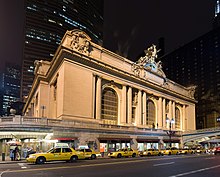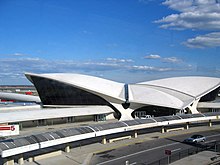Mass transit in New York City, most of which runs 24 hours a day, is the most complex and extensive in North America. About one in every three users of mass transit in the United States and two-thirds of the nation's rail riders live in New York and its suburbs. The iconic New York City Subway system is the busiest in the Western Hemisphere, while Grand Central Terminal, also popularly referred to as "Grand Central Station", is the world's largest railway station by number of platforms. New York's airspace is one of the world's busiest air transportation corridors. The George Washington Bridge, connecting Manhattan to Bergen County, New Jersey, is the world's busiest motor vehicle bridge.
Public transit is New York City's most popular mode of transit. 54.6% of New Yorkers commuted to work in 2005 using mass transit. This is in contrast to the rest of the United States, where about 90% of commuters drive automobiles to their workplace. According to the US Census Bureau, New York City residents spend an average of 38.4 minutes a day getting to work, the longest commute time in the nation among large cities.
New York City is served by Amtrak, which uses Pennsylvania Station. Amtrak provides connections to Boston, Philadelphia, and Washington, D.C. along the Northeast Corridor and long-distance train service to cities such as Chicago, New Orleans,Miami, Toronto and Montreal. The Port Authority Bus Terminal, the main intercity bus terminal of the city, serves 7,000 buses and 200,000 commuters daily, making it the busiest bus station in the world.
The New York City Subway is the largest rapid transit system in the world when measured by stations in operation, with 468. It is the third-largest when measured by annual ridership (1.5 billion passenger trips in 2006). New York's subway is also notable because nearly all the system remains open 24 hours a day, in contrast to the overnight shutdown common to systems in most cities, including London, Paris, Montreal, Washington, Madrid and Tokyo. The transportation system in New York City is extensive and complex. It includes the longest suspension bridge in North America, the world's first mechanically ventilated vehicular tunnel, more than 12,000 yellow cabs, an aerial tramway that transports commuters between Roosevelt Island and Manhattan, and a ferry system connecting Manhattan to various locales within and outside the city. The busiest ferry in the United States is the Staten Island Ferry, which annually carries over 19 million passengers on the 5.2-mile (8.4 km) run between Staten Island and Lower Manhattan. The Staten Island Railway rapid transit system solely serves Staten Island. The "PATH" train (short for Port Authority Trans-Hudson) links Midtown and Lower Manhattan to northeastern New Jersey, primarily Hoboken, Jersey City and Newark. Like the New York City Subway, the PATH operates 24 hours a day; meaning two of the four rapid transit systems in the world which operate on 24-hour schedules are wholly or partly in New York (the others are a portion of the Chicago "L" and the PATCO Speedline serving Philadelphia).
New York City's public bus fleet and commuter rail network are the largest in North America. The rail network, connecting the suburbs in the tri-state region to the city, consists of the Long Island Rail Road, Metro-North Railroad and New Jersey Transit. The combined systems converge at Grand Central Terminal and Pennsylvania Stationand contain more than 250 stations and 20 rail lines.
New York City is the top international air passenger gateway to the United States. The area is served by three major airports, John F. Kennedy International, Newark Liberty International and LaGuardia, with plans for a fourth airport, Stewart International Airport near Newburgh, New York, to be taken over and enlarged by the Port Authority of New York and New Jersey (which administers the other three airports), as a "reliever" airport to help cope with increasing passenger volume. 100 million travelers used the three airports in 2005 and the city's airspace is the busiest in the nation. Outbound international travel from JFK and Newark accounted for about a quarter of all U.S. travelers who went overseas in 2004. JFK Airport is the largest hub for JetBlue. It is the fourth largest hub for American Airlines and is the sixth largest hub for Delta Air Lines. Newark Airport will be the third largest hub for United Airlines once they complete their merger with Continental Airlines. This will make United Airlines the largest airline in the New York market.
New York's high rate of public transit use, 120,000 daily cyclists and many pedestrian commuters makes it the most energy-efficient major city in the United States. Walk and bicycle modes of travel account for 21% of all modes for trips in the city; nationally the rate for metro regions is about 8%.
To complement New York's vast mass transit network, the city also has an extensive web of expressways and parkways, that link New York City to Northern New Jersey,Westchester County, Long Island, and southwest Connecticut through various bridges and tunnels. Because these highways serve millions of suburban residents who commute into New York, it is quite common for motorists to be stranded for hours in traffic jams that are a daily occurrence, particularly during rush hour.
Despite New York's reliance on public transit, roads are a defining feature of the city. Manhattan's street grid plan greatly influenced the city's physical development. Several of the city's streets and avenues, like Broadway, Wall Street and Madison Avenue are also used as metonyms for national industries located there: the theater, finance, and advertising organizations, respectively.




No comments:
Post a Comment